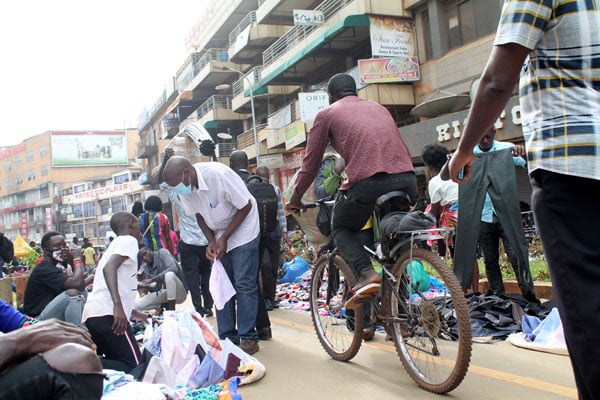Why KCCA non-motorised plan is failing

Vendors and cyclists in a non-motorised lane on Luwum Street, downtown Kampala on July 14. PHOTO/ KELVIN ATUHAIRE
What you need to know:
- Ms Claire Birungi, the country manager of Institute for Transportation and Development Policy, said streets are public places, and no one should be chased away when using them.
- She advised KCCA to plan and organise the streets better to accommodate vendors.
- “We have the space on the streets but we have not organised the space well. Vendors can be placed in the spaces under trees and shades because it is their livelihood. The space can be organised for everyone, including the utility vendor zones,” Ms Birungi said.
Kampala Capital City Authority (KCCA) is finding it difficult to enforce order at the pilot non-motorised transport (NMT) corridors that stretch from Namirembe Road to Luwum Street.
The corridors, which were completed during the coronavirus lockdown, have two metre cycling lanes on both sides while the walkways are four metres wide to allow vehicle access in restricted hours.
Although the authority says the design of the NMT was to allow easy access to the city centre and businesses to thrive in less congested spaces, they are facing disruption from motorists.
“Our challenge with implementation is with the vendors downtown. If they do not see the blue or yellow shirt (uniform for enforcement officers), they will not move. Currently, we are into the political season and enforcement has declined to maintain harmony, which is unfortunate. That is why you see many vendors on the streets. What is lacking is the political will to enforce (the order),” Mr Andrew Sserunjojji, a KCCA engineer, said.
“We targeted the corridor between Namirembe Road and Entebbe Road because at that time, UN habitat and other stakeholders carried out a study which revealed that that was one of the most congested areas of the city that deserved to be converted into an NMT corridor,” he added.
Mr Sserunjonjji said they received complaints from traders in downtown, protesting the presence of vehicles in the area. “All the shop owners in Kikuubo did not want vehicles there because they compromise their sales. People park trucks in front of their shops so they cannot sell their merchandise. The compromise we had to make was to allow a one way flow from Pride Theatre to Ham shopping Centre,” he said.
The planning section of KCCA says sensitisation of road users have been done but building owners complained of cargo trucks not accessing shops and stores. “People going downtown to shop do not need to come with a car to buy their merchandise. All we need to do is create for them infrastructure where traders can load merchandise at night and vendors come during the day and take the merchandise out of the city. That is the strategy we want to implement,” Mr Sserunjojji said.
Plea
Kampala Lord Mayor Erias Lukwago told a meeting for media engagement on NMT last Friday that he would rather walk from City Hall to Luwum Street to attend an event than get stuck in traffic.
“Walking is not comfortable in Kampala. It is not enjoyable. That is something we have to find answers to. Those who are enjoying walking are only in upscale areas like in Kololo, but down town Kampala, it is not enjoyable. That is where we should focus our attention,” Mr Lukwago said.
However, Mr Sserunjojji said they had to compromise the design to consider other stakeholders.
“For instance, from Pride Theatre to Jaguar, we received complaints from petrol stations that were upstream, saying they were to sue KCCA for loss of business. So we had to convert that section into a two-way traffic flow,” he said.




